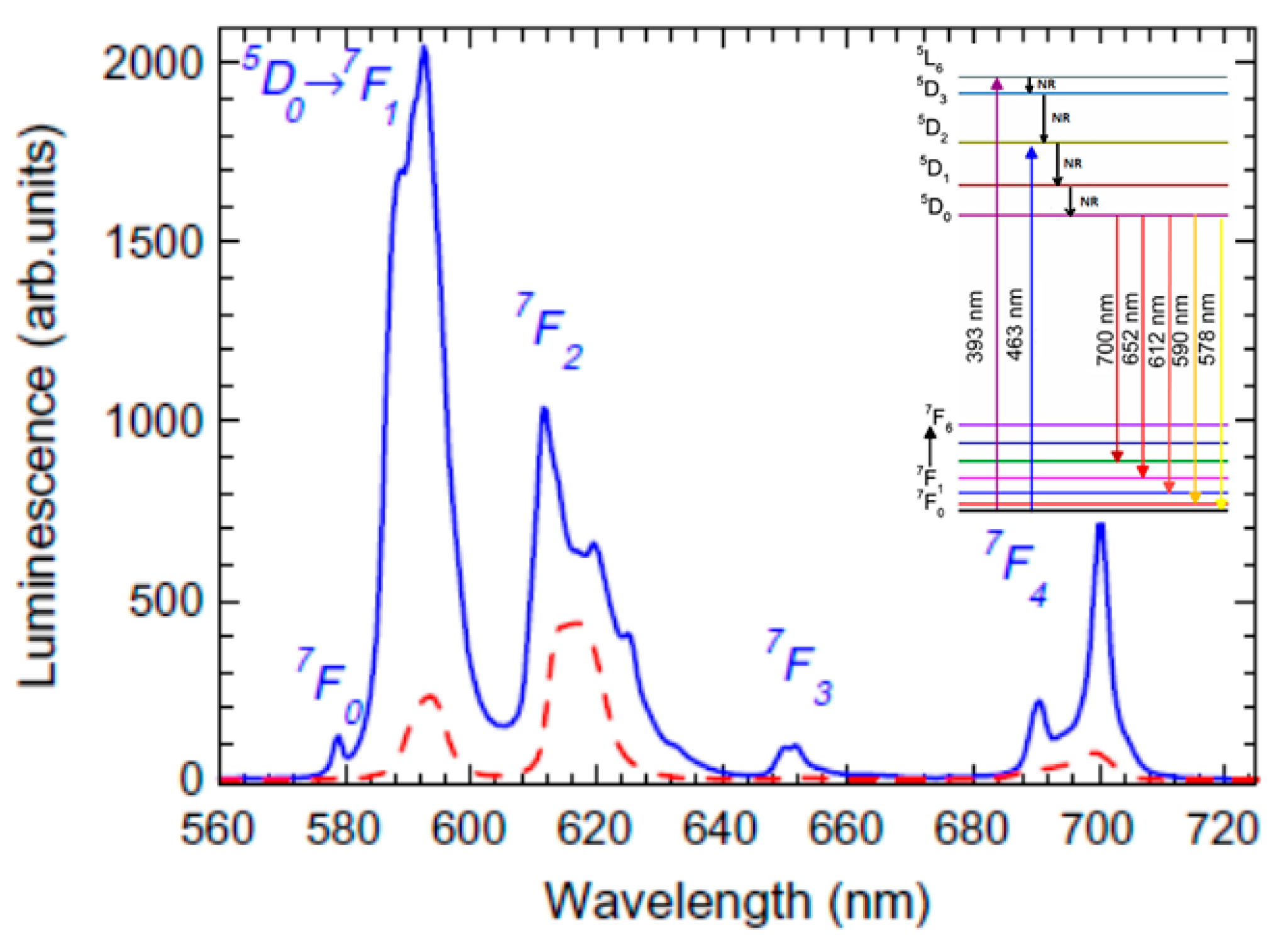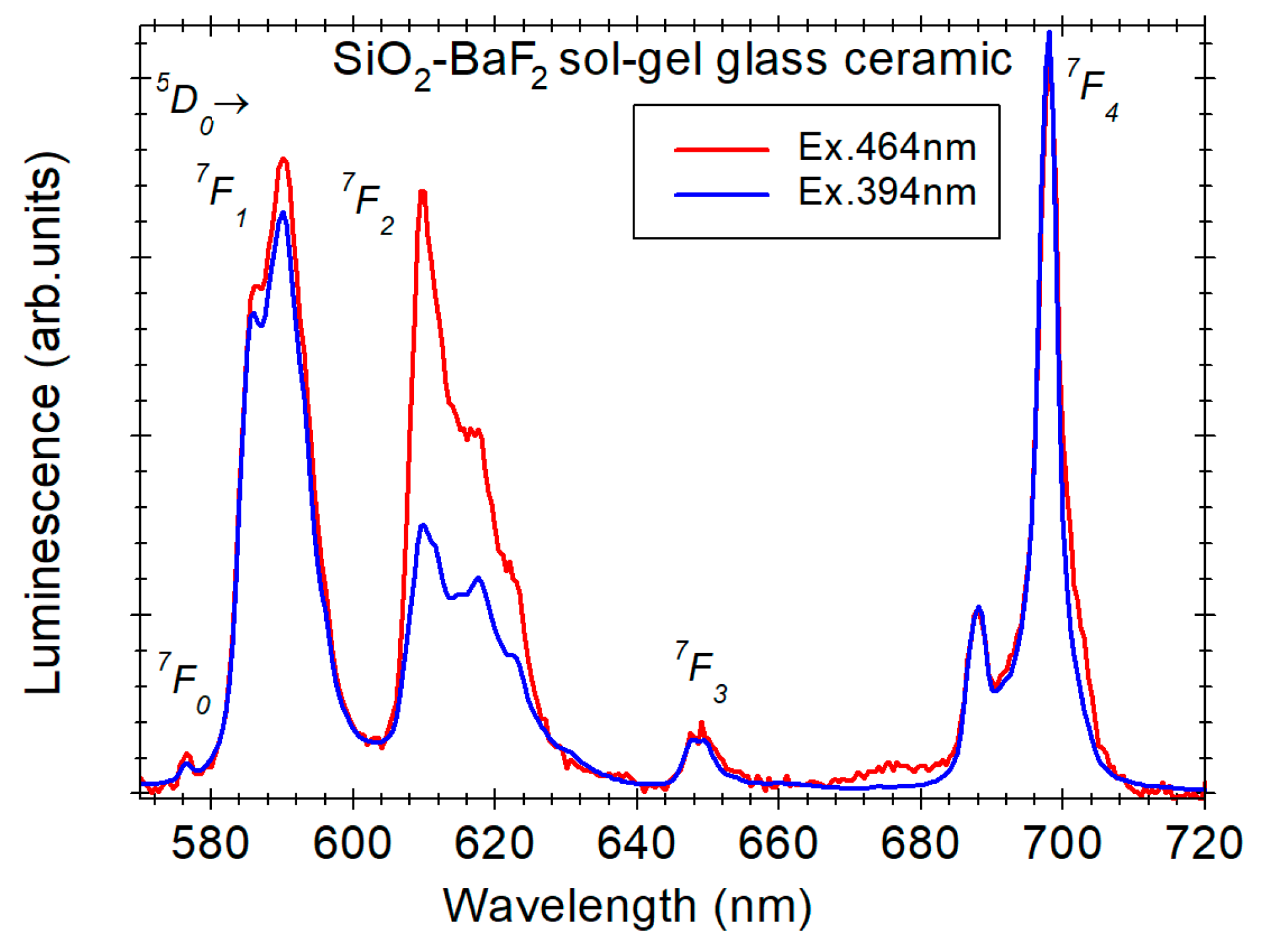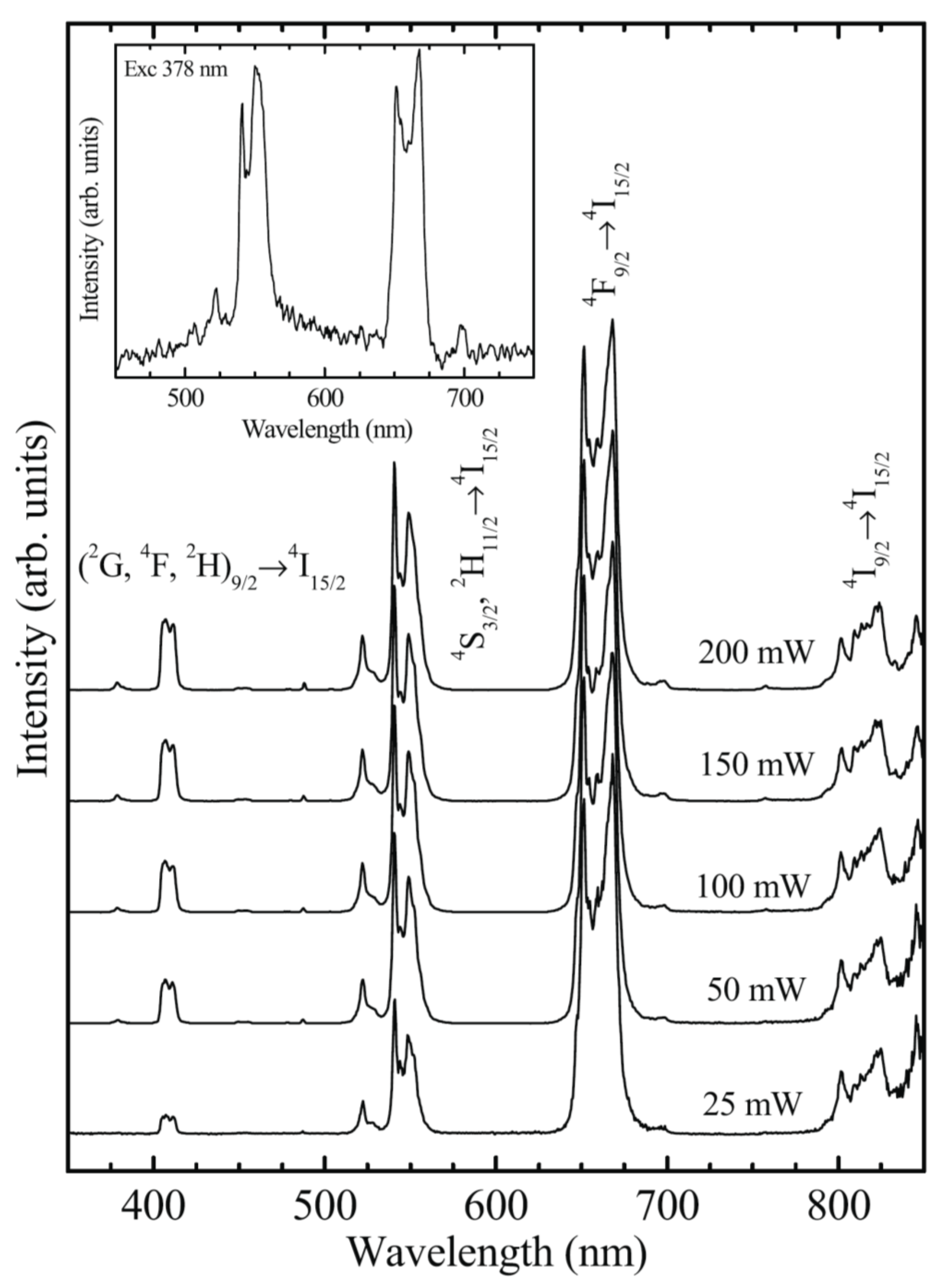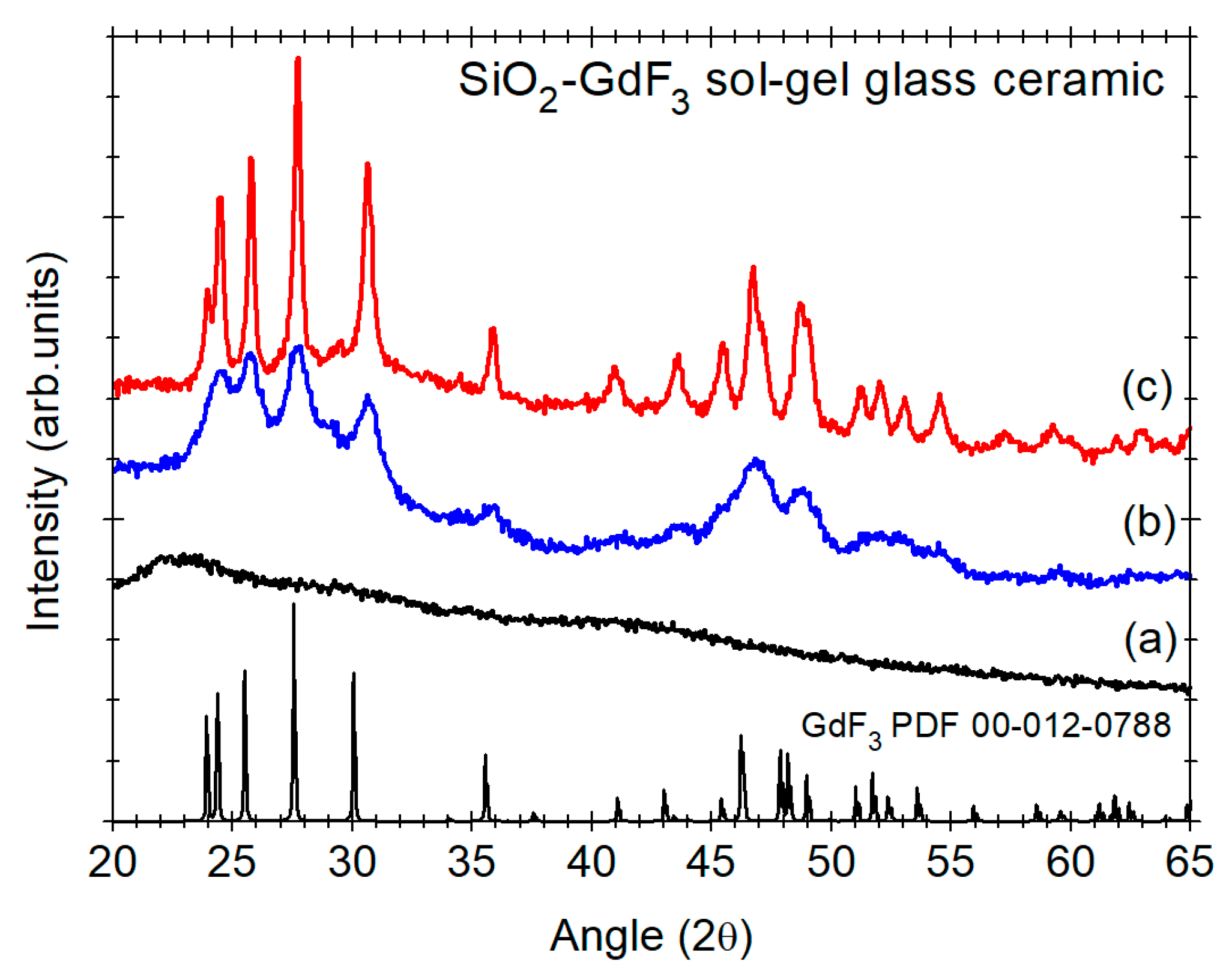Optical Properties of Transparent Rare-Earth Doped Sol-Gel Derived Nano-Glass Ceramics
Abstract
:1. Introduction
2. Sol-Gel Method for Glass Ceramic Synthesis
2.1. Crystallization Mechanism
2.2. Optical Properties: Photoluminescence, Up-Conversion Luminescence, and Thermoluminescence
3. Oxyfluoride Glass Ceramic
3.1. SiO2–MeF2 Oxyfluoride Glass ceramic (with Me = Mg, Ca, Sr, Ba, Pb)
3.1.1. SiO2–CaF2 Oxyfluoride Glass Ceramic
3.1.2. SiO2–SrF2 Oxyfluoride Glass Ceramic
3.1.3. SiO2–BaF2 Oxyfluoride Glass Ceramic
3.1.4. SiO2–PbF2 Oxyfluoride Glass Ceramic
3.2. SiO2–MeF3 Oxyfluoride Glass Ceramic (with Me = La, Y, Gd, Ce)
3.2.1. SiO2–LaF3 Oxyfluoride Glass Ceramic
3.2.2. SiO2–YF3 Oxyfluoride Glass Ceramic
3.2.3. SiO2–MeF3 Oxyfluoride Glass Ceramic (with Me = Gd, Ce)
4. Thernary and More Complex Oxyfluoride Glass Ceramic
5. Oxychloride Glass Ceramic
6. Perspectives and Applications
7. Conclusions
Author Contributions
Funding
Conflicts of Interest
Abbreviations
| DSC | differential scanning calorimetry |
| ET | energy transfer |
| FTIR | Fourier transform infrared spectroscopy |
| IR | Infrared |
| NIR | near infrared |
| PL | photoluminescence |
| PSB | phonon side bands |
| PSHB | persistent spectral hole burning |
| RE | rare earth |
| TEOS | Tetraethyl orthosilicate, formally named tetraethoxysilane |
| TFA | trifluoroacetic acid |
| TG | thermogravimetry |
| TEM | Transmission electronmicroscopy |
| TL | Thermoluminescence |
| TMOS | Tetramethyl orthosilicate |
| UC | up-conversion |
| UV | ultraviolet |
| XRD | X-ray diffraction |
References
- Deubener, J.; Allix, M.; Davis, M.J.; Duran, A.; Höche, T.; Honma, T.; Komatsu, T.; Krüger, S.; Mitra, I.; Müller, R.; et al. Updated definition of glass-ceramics. J. Non-Cryst. Solids 2018, 501, 3–10. [Google Scholar] [CrossRef]
- Pablos-Martin, A.; Duran, A.; Pascual, M.J. Nanocrystallisation in oxyfluoride systems: Mechanisms of crystallization and photonic properties. Int. Mater. Rev. 2012, 57, 165–186. [Google Scholar] [CrossRef]
- Brinker, C.J.; Scherer, G. Sol-Gel Science: The Physics and Chemistry of Sol-Gel Processing, 1st ed.; Academic Press Inc.: New York, NY, USA, 1990; Levy, D.; Zayat, M. The Sol-Gel Handbook: Synthesis, Characterization and Applications; Wiley-VCH: Weinheim, Germany, 2015. [Google Scholar]
- Gorni, G.; Velázquez, J.J.; Mosa, J.; Balda, R.; Fernández, J.; Durán, A.; Castro, Y. Transparent Glass-Ceramics Produced by Sol-Gel: A Suitable Alternative for Photonic Materials. Materials 2018, 11, 212. [Google Scholar] [CrossRef] [Green Version]
- Fujihara, S.; Mochizuki, C.; Kimura, T. Formation of LaF3 microcrystals in sol-gel silica. J. Non-Cryst. Solids 1999, 244, 267–274. [Google Scholar] [CrossRef]
- Fujihara, S.; Kato, T.; Kimura, T. Influence of solution composition on the formation of SiO2/LaF3 composites in the sol-gel process. J. Mater. Sci. 2000, 35, 2763–2767. [Google Scholar] [CrossRef]
- Fujihara, S.; Tada, M.; Kimura, T. Preparation and characterization of MgF2 thin film by a trifluoroacetic acid method. Thin Solid Films 1997, 304, 252–255. [Google Scholar] [CrossRef]
- Secu, C.E.; Bartha, C.; Polosan, S.; Secu, M. Thermally activated conversion of a silicate gel to an oxyfluoride glass ceramic: Optical study using Eu3+ probe ion. J. Lumin. 2014, 146, 539–543. [Google Scholar] [CrossRef]
- Almeida, R.M.; Goncalves, M.C. Crystallization of Sol-gel Derived Glasses. Int. J. Appl. Glass Sci. 2014, 5, 114–125. [Google Scholar] [CrossRef]
- Gorni, G.; Pascual, M.J.; Caballero, A.; Velázquez, J.J.; Mosa, J.; Castro, Y.; Durán, A. Crystallization mechanism in sol-gel oxyfluoride glass-ceramics. J. Non-Cryst. Solids 2018, 501, 145–152. [Google Scholar] [CrossRef]
- Yu, Y.; Chen, D.; Wang, Y.; Luo, W.; Zheng, Y.; Cheng, Y.; Zhou, L. Structural evolution and its influence on luminescence of SiO2–SrF2–ErF3 glass ceramics prepared by sol–gel method. Mater. Chem. Phys. 2006, 100, 241–245. [Google Scholar] [CrossRef]
- Szpikowska-Sroka, B.; Zur, L.; Czoik, R.; Goryczka, T.; Swinarew, A.S.; Zadło, M.; Pisarski, W.A. Long-lived emission from Eu3+-doped PbF2 nanocrystals distributed into sol–gel silica glass. J. Sol-Gel Sci. Technol. 2013, 68, 278–283. [Google Scholar] [CrossRef] [Green Version]
- Luo, W.; Wang, Y.; Cheng, Y.; Bao, F.; Zhou, L. Crystallization and structural evolution of SiO2-YF3 xerogel. Mater. Sci. Eng. B 2006, 127, 218–223. [Google Scholar] [CrossRef]
- Farjasa, J.; Campsa, J.; Rouraa, P.; Ricartb, S.; Puigb, T.; Obradors, X. The thermal decomposition of barium trifluoroacetate. Thermochim. Acta 2012, 544, 77–83. [Google Scholar] [CrossRef]
- Secu, M.; Secu, C.E.; Ghica, C. Eu3+-doped CaF2 nanocrystals in sol–gel derived glass–ceramics. Opt. Mater. 2011, 33, 613–617. [Google Scholar] [CrossRef]
- Rüssel, C. Thermal decomposition of metal trifluoracetates. J. Non-Cryst. Solids 1993, 152, 161–166. [Google Scholar] [CrossRef]
- Nogami, M.; Abe, Y. Properties of sol-gel-derived Al2O3-SiO2 glasses using Eu3+ ion fluorescence spectra. J. Non-Cryst. Solids 1996, 197, 73–78. [Google Scholar] [CrossRef]
- Gorni, G.; Velázquez, J.J.; Mosa, J.; Mather, G.C.; Serrano, A.; Vila, M.; Castro, G.R.; Bravo, D.; Balda, R.; Fernández, J.; et al. Transparent Sol-Gel Oxyfluoride Glass-Ceramics with High Crystalline Fraction and Study of RE Incorporation. Nanomaterials 2019, 9, 530. [Google Scholar] [CrossRef] [PubMed] [Green Version]
- Secu, C.E.; Secu, M.; Ghica, C.; Mihut, L. Rare-earth doped sol–gel derived oxyfluoride glass–ceramics: Structural and optical characterization. Opt. Mater. 2011, 33, 1770–1774. [Google Scholar] [CrossRef]
- Pawlik, N.; Szpikowska-Sroka, B.; Pietrasik, E.; Goryczka, T.; Pisarski, W.A. Structural and luminescence properties of silica powders and transparent glass-ceramics containing LaF3:Eu3+ nanocrystals. J. Am. Ceram. Soc. 2018, 101, 4654–4668. [Google Scholar] [CrossRef]
- Bartha, C.; Secu, C.E.; Matei, E.; Negrila, C.; Leca, A.; Secu, M. Towards a Correlation between Structural, Magnetic, and Luminescence Properties of CeF3:Tb3+ Nanocrystals. Materials 2020, 13, 2980. [Google Scholar] [CrossRef]
- Secu, C.E.; Matei, E.; Negrila, C.; Secu, M. The influence of the nanocrystals size and surface on the Yb/Er doped LaF3 luminescence properties. J. Alloys Compd. 2019, 791, 1098–1104. [Google Scholar] [CrossRef]
- Yanes, A.C.; Santana-Alonso, A.; Méndez-Ramos, J.; del Castillo, J.; Rodriguez, V.D. Novel Sol–Gel Nano-Glass–Ceramics Comprising Ln3+-Doped YF3 Nanocrystals: Structure and High Efficient UV Up-Conversion. Adv. Funct. Mater. 2011, 21, 3136–3142. [Google Scholar] [CrossRef]
- Binnemans, K.; Gorller-Walrand, C. Application of the Eu3+ ion for site symmetry determination. J. Rare Earths 1996, 14, 173–180. [Google Scholar]
- Driesen, K.; Tikhomirov, V.K.; Gorller-Walrand, C. Eu3+ as a probe for rare-earth dopant site structure in nano-glass-ceramics. J. Appl. Phys. 2007, 102, 024312. [Google Scholar] [CrossRef]
- Lochhead, M.J.; Bray, K.L. Spectroscopic characterization of doped sol-gel silica gels and glasses: Evidence of inner-sphere complexation of europium(III). J. Non-Cryst. Solids 1994, 170, 143–154. [Google Scholar] [CrossRef]
- Devlin, K.; O’ Kelly, B.; Tang, Z.R.; McDonagh, C.; McGilp, J.F. A structural study of the sol-gel process by optical fluorescence and decay time spectroscopy. J. Non-Cryst. Solids 1991, 135, 8–14. [Google Scholar] [CrossRef]
- Secu, C.E.; Polosan, S.; Secu, M. Magneto-optical investigations of rare earth doped sol–gel derived silicate xerogel. J. Lumin. 2011, 131, 1747–1752. [Google Scholar] [CrossRef]
- Reisfeld, R.; Zigansky, E.; Gaft, M. Europium probe for estimation of site symmetry in glass films, glasses and crystals. Mol. Phys. 2004, 102, 1319–1330. [Google Scholar] [CrossRef]
- Secu, C.E.; Negrea, R.F.; Secu, M. Eu3+ probe ion for rare-earth dopant site structure in sol–gel derived LiYF4 oxyfluoride glass–ceramic. Opt. Mater. 2013, 35, 2456–2460. [Google Scholar] [CrossRef]
- Auzel, F. Upconversion and Anti-Stokes Processes with f and d Ions in Solids. Chem. Rev. 2004, 104, 139–174. [Google Scholar] [CrossRef]
- Secu, M. Up-conversion properties of sol-gel derived Yb3+/Er3+-doped oxyfluoride glass-ceramics. unpublished work.
- McKeever, S.W.S. Thermoluminescence of Solids; Cambridge University Press: New York, NY, USA, 1985. [Google Scholar]
- Bos, A.J.J. Thermoluminescence as a Research Tool to Investigate Luminescence Mechanisms. Materials 2017, 10, 1357. [Google Scholar] [CrossRef] [PubMed] [Green Version]
- Bos, A.J.J.; Dorenbos, P.; Bessière, A.; Viana, B. Lanthanide energy levels in YPO4. Radiat. Meas. 2008, 43, 222–226. [Google Scholar] [CrossRef]
- Krumpel, A.H.; van der Kolk, E.; Zeelenberg, D.; Bos, A.J.J.; Krämer, K.W.; Dorenbos, P. Lanthanide 4f-level location in lanthanide doped and cerium-lanthanide codoped NaLaF4 by photo- and thermoluminescence. J. Appl. Phys. 2008, 104, 073505. [Google Scholar] [CrossRef] [Green Version]
- Rodnyi, P.A.; Khodyuk, I.V.; Stryganyuk, G.B. Location of the Energy Levels of the Rare-Earth Ion in BaF2 and CdF2. Phys. Solid State 2008, 50, 1639–1643. [Google Scholar] [CrossRef] [Green Version]
- Secu, M.; Secu, C.; Sima, M. Sol–gel template synthesis of luminescent glass–ceramic rods. J. Nanopart. Res. 2012, 14, 772. [Google Scholar] [CrossRef]
- Zhou, L.; Chen, D.; Luo, W.; Wang, Y.; Yu, Y.; Liu, F. Transparent glass ceramic containing Er3+:CaF2 nano-crystals prepared by sol–gel method. Mater. Lett. 2007, 61, 3988–3990. [Google Scholar] [CrossRef]
- Georgescu, S.; Voiculescu, A.M.; Matei, C.; Secu, C.E.; Negrea, R.F.; Secu, M. Ultraviolet and visible up-conversion luminescence of Er3+/Yb3+ co-doped CaF2 nanocrystals in sol–gel derived glass-ceramics Journal ofLuminescence. J. Lumin. 2013, 143, 150–156. [Google Scholar] [CrossRef]
- Kłonkowski, A.M.; Wiczk, W.; Ryl, J.; Szczodrowski, K.; Wileńska, D. A white phosphor based on oxyfluoride nano-glass-ceramics codoped with Eu3+ and Tb3+: Energy transfer study (SrF2). J. Alloys Compd. 2017, 724, 649–658. [Google Scholar] [CrossRef]
- Yu, Y.; Wang, Y.; Chen, D.; Liu, F. Efficient upconversion luminescence of Er3+:SrF2-SiO2-Al2O3 sol-gel glass ceramics. Ceram. Int. 2008, 34, 2143–2146. [Google Scholar] [CrossRef]
- Chen, D.; Wang, Y.; Yu, Y.; Ma, E.; Zhou, L. Microstructure and luminescence of transparent glass ceramic containing Er3+:BaF2 nano-crystals. J. Solid State Chem. 2006, 179, 532–537. [Google Scholar] [CrossRef]
- Luo, W.; Wang, Y.; Bao, F.; Zhou, L.; Wang, X. Crystallization behavior of PbF2-SiO2 based bulk xerogels. J. Non-Cryst. Solids 2004, 347, 31–38. [Google Scholar] [CrossRef]
- Szpikowska-Sroka, B.; Pawlik, N.; Goryczka, T.; Pietrasik, E.; Bańczyk, M.; Pisarski, W.A. Lead fluoride β-PbF2 nanocrystals containing Eu3+ and Tb3+ ions embedded in sol-gel materials: Thermal, structural and optical investigations. Ceram. Int. 2017, 43, 8424–8432. [Google Scholar] [CrossRef]
- Szpikowska-Sroka, B.; Pawlik, N.; Goryczka, T.; Pisarski, W.A. Eu3+/Tb3+ codoped PbF2 nanocrystals in sol–gel glass–ceramic materials: Fabrication, structure and properties. Mater. Sci. Eng. B 2021, 263, 114884. [Google Scholar] [CrossRef]
- Del-Castillo, J.; Yanes, A.C.; Méndez-Ramos, J.; Tikhomirov, V.K.; Rodríguez, V.D. Structure and up-conversion luminescence in sol–gel derived Er3+–Yb3+ co-doped SiO2:PbF2 nano-glass–ceramics. Opt. Mater. 2009, 32, 104–107. [Google Scholar] [CrossRef]
- Del-Castillo, J.; Yanes, A.C.; Mendez-Ramos, J.; Tikhomirov, V.K.; Moshchalkov, V.V.; Rodrıguez, V.D. Sol–gel preparation and white up-conversion luminescence in rare-earth doped PbF2 nanocrystals dissolved in silica glass. J. Sol-Gel. Sci. Technol. 2010, 53, 509–514. [Google Scholar] [CrossRef] [Green Version]
- Yanes, A.C.; del-Castillo, J.; Mendez-Ramos, J.; Rodrıguez, V.D.; Torres, M.E.; Arbiol, J. Luminescence and structural characterization of transparent nanostructured Eu3+-doped LaF3–SiO2 glass–ceramics prepared by sol–gel method. Opt. Mater. 2007, 29, 999–1003. [Google Scholar] [CrossRef]
- Pawlik, N.; Szpikowska-Sroka, B.; Goryczka, T.; Pisarski, W.A. Studies of Sol-Gel Evolution and Distribution of Eu3+ Ions in Glass–Ceramics Containing LaF3 Nanocrystals Depending on Initial Sols Composition. Int. J. Mol. Sci. 2021, 22, 996. [Google Scholar] [CrossRef] [PubMed]
- Pawlik, N.; Szpikowska-Sroka, B.; Pitrasik, E.; Goryczka, T.; Dulski, M.; Swinarew, A.S.; Zubko, M.; Lelątko, J.; Pisarski, W.A. Reddish-orange Eu3+-doped sol-gel emitters based on LaF3 nanocrystals—Synthesis, structural and photoluminescence investigations. Opt. Mater. 2019, 89, 276–282. [Google Scholar] [CrossRef]
- Rodriguez, V.D.; del Castillo, J.; Yanes, A.C.; Mendez-Ramos, J.; Torres, M.; Peraza, J. Luminescence of Er3+-doped nanostructured SiO2–LaF3 glass-ceramics prepared by the sol–gel method. Opt. Mater. 2007, 29, 1557–1561. [Google Scholar] [CrossRef]
- Biswas, A.; Maciel, G.S.; Friend, C.S.; Prasad, P.N. Upconversion properties of a transparent Er3+–Yb3+ co-doped LaF3–SiO2 glass-ceramics prepared by sol–gel method. J. Non-Cryst. Solids 2003, 16, 393–397. [Google Scholar] [CrossRef]
- Méndez-Ramos, J.; Velázquez, J.J.; Yanes, A.C.; del-Castillo, J.; Rodríguez, V.D. Up-conversion in nanostructured Yb3+–Tm3+ co-doped sol–gel derived SiO2–LaF3 transparent glass-ceramics. Phys. Status Solidi A 2008, 205, 330–334. [Google Scholar] [CrossRef]
- Velázquez, J.J.; Yanes, A.C.; del Castillo, J.; Méndez-Ramos, J.; Rodríguez, V.D. Optical properties of Ho3+–Yb3+ co-doped nanostructured SiO2–LaF3 glass-ceramics prepared by sol–gel method. Phys. Status Solidi A 2007, 204, 1762–1768. [Google Scholar] [CrossRef]
- Yanes, A.C.; Velaszquez, J.J.; del-Castillo, J.; Mendez-Ramos, J.; Rodrıguez, V.D. Colour tuneability and white light generation in Yb3+–Ho3+–Tm3+ co-doped SiO2–LaF3 nano-glass-ceramics prepared by sol–gel method. J. Sol-Gel Sci. Technol. 2009, 51, 4–9. [Google Scholar] [CrossRef]
- Pawlik, N.; Szpikowska-Sroka, B.; Goryczka, T.; Zubko, M.; Lelątko, J.; Pisarski, W.A. Structure and luminescent properties of oxyfluoride glass-ceramics with YF3:Eu3+ nanocrystals derived by sol-gel method. J. Eur. Ceram. Soc. 2019, 39, 5010–5017. [Google Scholar] [CrossRef]
- Pawlik, N.; Szpikowska-Sroka, B.; Pisarski, W.A. Energy Transfer Study on Tb3+/Eu3+ Co-Activated Sol-Gel Glass-Ceramic Materials Containing MF3 (M = Y, La) Nanocrystals for NUV Optoelectronic Devices. Materials 2020, 13, 2522. [Google Scholar] [CrossRef]
- Fujihara, S.; Koji, S.; Kimura, T. Structure and Optical Properties of (Gd,Eu)F3-Nanocrystallized Sol-Gel Silica Films. J. Mater. Chem. 2004, 14, 1331–1335. [Google Scholar] [CrossRef]
- Velázquez, J.J.; Mosa, J.; Gorni, G.; Balda, R.; Fernández, J.; Pascual, L.; Durán, A.; Castro, Y. Transparent SiO2-GdF3 sol–gel nano-glass ceramics for optical applications. J. Sol-Gel Sci. Technol. 2019, 89, 322–332. [Google Scholar] [CrossRef]
- Pawlik, N.; Szpikowska-Sroka, B.; Sołtys, M.; Pisarski, W.A. Optical properties of silica sol-gel materials singly- and doubly doped with Eu3+and Gd3+ ions. J. Rare Earths 2016, 34, 786–795. [Google Scholar] [CrossRef]
- Szpikowska-Sroka, B.; Pawlik, N.; Goryczka, T.; Pisarski, W.A. Influence of silicate sol-gel host matrices and catalyst agents on luminescence properties of Eu3+/Gd3+ under different excitation wavelengths. RSC Adv. 2015, 5, 98773–98782. [Google Scholar] [CrossRef]
- Pawlik, N.; Szpikowska-Sroka, B.; Pietrasik, E.; Goryczka, T.; Pisarski, W.A. Photoluminescence and energy transfer in transparent glass-ceramics based on GdF3:RE3+ (RE = Tb, Eu) nanocrystals. J. Rare Earths 2019, 37, 1137–1144. [Google Scholar] [CrossRef]
- Secu, M.; Secu, C.E. Photoluminescence and energy transfer processes in Eu3+-doped SiO2–GdF3 oxyfluoride glass-ceramics prepared by sol-gel. manuscript in preparation.
- Secu, C.E.; Bartha, C.; Secu, M. Dual up-conversion luminescence and magnetic properties of sol-gel derived Er3+/Yb3+ doped SiO2-GdF3 nano-glass ceramics. manuscript in preparation.
- del Castillo, J.; Yanes, A.C.; Méndez-Ramos, J.; Velázquez, J.J.; Rodríguez, V.D. Structural and luminescent study in lanthanide doped sol–gel glass–ceramics comprising CeF3 nanocrystals. J. Sol-Gel Sci. Technol. 2011, 60, 170–176. [Google Scholar] [CrossRef]
- Santana-Alonso, A.; Yanes, A.C.; Méndez-Ramos, J.; del Castillo, J.; Rodríguez, V.D. Sol–gel transparent nano-glass–ceramics containing Eu3+-doped NaYF4 nanocrystals. J. Non-Cryst. Solids 2010, 356, 933–936. [Google Scholar] [CrossRef]
- Cruz, M.E.; Li, J.; Gorni, G.; Durán, A.; Mather, G.C.; Balda, R.; Fernández, J.; Castro, Y. Crystallization Process and Site-Selective Excitation of Nd3+ in LaF3/NaLaF4 Sol–Gel-Synthesized Transparent Glass-Ceramics. Crystals 2021, 11, 464. [Google Scholar] [CrossRef]
- Velázquez, J.J.; Mosa, J.; Gorni, G.; Balda, R.; Fernández, J.; Durán, A.; Castro, Y. Novel sol-gel SiO2-NaGdF4 transparent nano-glass-ceramics. J. Non-Cryst. Solids 2019, 520, 119447. [Google Scholar] [CrossRef]
- Cruz, M.E.; Li, J.; Gorni, G.; Durán, A.; Mather, G.C.; Balda, R.; Fernández, J.; Castro, Y. Nd3+doped- SiO2–KLaF4 oxyfluoride glass-ceramics prepared by sol-gel. J. Lumin. 2021, 235, 118035. [Google Scholar] [CrossRef]
- Yanes, A.C.; del-Castillo, J. Enhanced emission via energy transfer in RE co-doped SiO2-KYF4 nano-glass-ceramics for white LEDs. J. Alloys Compd. 2016, 658, 170–176. [Google Scholar] [CrossRef]
- Kawamura, G.; Yoshimura, R.; Ota, K.; Oh, S.I.; Hakiri, N.; Muto, H.; Hayakawa, T.; Matsuda, A. A unique approach to characterization of sol–gel-derived rare-earth-doped oxyfluoride glass-ceramics. J. Am. Ceram. Soc. 2013, 96, 476–480. [Google Scholar] [CrossRef]
- Secu, M.; Secu, C.E. Up-conversion luminescence of Er3+/Yb3+ co-doped LiYF4 nanocrystals in sol–gel derived oxyfluoride glass-ceramics. J. Non-Cryst. Solids 2015, 426, 78–82. [Google Scholar] [CrossRef]
- Yanes, A.C.; Santana-Alonso, A.; Méndez-Ramos, J.; del-Castillo, J.; Rodríguez, V.D. Yb3+–Er3+ co-doped sol–gel transparent nano-glass-ceramics containing NaYF4 nanocrystals for tuneable up-conversion phosphors. J. Alloys Compd. 2009, 480, 706–710. [Google Scholar] [CrossRef]
- Méndez-Ramos, J.; Yanes, A.C.; Santana-Alonso, A.; del-Castillo, J. Highly efficient up-conversion and bright white light in RE co-doped KYF4 nanocrystals in sol–gel silica matrix. Chem. Phys. Lett. 2013, 555, 196–201. [Google Scholar] [CrossRef]
- Del-Castillo, J.; Yanes, A.C.; Abé, S.; Smet, P.F. Site selective spectroscopy in BaYF5:RE3+ (RE = Eu, Sm) nano-glass–ceramics. J. Alloys Compd. 2015, 635, 136–141. [Google Scholar] [CrossRef] [Green Version]
- Yanes, A.C.; del-Castillo, J. Bright luminescence of Gd3+ sensitized RE3+-doped SiO2-BaGdF5 glass-ceramics for UV-LEDs colour conversion. J. Alloys Compd. 2017, 695, 3736–3743. [Google Scholar] [CrossRef] [Green Version]
- Del-Castillo, J.; Yanes, A.C. Ultraviolet and visible up-conversion in sol-gel based SiO2-BaY0.78-xGdxYb0.2Tm0.02F5 nano-glass-ceramics. Opt. Mater. 2018, 84, 1–7. [Google Scholar] [CrossRef]
- Yanes, A.C.; del-Castillo, J.; Luis, D.; Puentes, J. Novel Sr2LuF7–SiO2 nano-glass-ceramics: Structure and up-conversion luminescence. J. Lumin. 2016, 170, 789–794. [Google Scholar] [CrossRef] [Green Version]
- Secu, M.; Secu, C.E. Up-conversion luminescence of BaCl2:Er3+ nanocrystals embedded in oxychloride nano-glass ceramic. J. Eur. Ceram. Soc. 2016, 36, 1699–1703. [Google Scholar] [CrossRef]
- Secu, M.; Secu, C.E.; Bartha, C. Crystallization and luminescence properties of a new Eu3+-doped LaOCl nano-glass-ceramic. J. Eur. Ceram. Soc. 2016, 36, 203–207. [Google Scholar] [CrossRef]
- Del Castillo, J.; Rodríguez, V.D.; Yanes, A.C.; Méndez-Ramos, J.; Torres, M.E. Luminescent properties of transparent nanostructured Eu3+ doped SnO2–SiO2 glass-ceramics prepared by the sol-gel method. Nanotechnology 2005, 16, S300–S303. [Google Scholar] [CrossRef] [Green Version]
- Van Tran, T.T.; Turrell, S.; Capoen, B.; Le Van, H.; Ferrari, M.; Ristic, D.; Boussekey, L.; Kinowski, C. Environment segregation of Er3+ emission in bulk sol-gel-derived SiO2-SnO2 glass ceramics. J. Mater. Sci. 2014, 49, 8226–8233. [Google Scholar] [CrossRef]
- Gonçalves, R.R.; Messaddeq, Y.; Chiasera, A.; Jestin, Y.; Ferrari, M.; Ribeiro, S.J.L. Erbium-activated silica-zirconia planar waveguides prepared by sol-gel route. Thin Solid Films 2008, 516, 3094–3097. [Google Scholar] [CrossRef]
- Oikawa, M.; Fujihara, S. Sol-Gel Preparation and Luminescent Properties of CeO2:Ln (Ln = Eu3+ and Sm3+) thin films. J. Eur. Ceram. Soc. 2005, 25, 2921–2924. [Google Scholar] [CrossRef]
- Jestin, Y.; Armellini, C.; Chiappini, A.; Chiaser, A.; Ferrari, M.; Goyes, C.; Montagna, M.; Moser, E.; Nunzi Conti, G.; Pelli, S.; et al. Erbium activated HfO2 based glass-ceramics waveguides for photonics. J. Non-Cryst. Solids 2007, 353, 494–497. [Google Scholar] [CrossRef]
- Beall, G.H.; Borrelli, N.F.; Pinckney, L. Laser-Induced Crystallization of Transparent Glass-Ceramics. U.S. Patent No. 6928224, 9 August 2005. [Google Scholar]
- Kajihara, K. Recent advances in sol–gel synthesis of monolithic silica and silica-based glasses. J. Asian Ceram. Soc. 2013, 1, 121–133. [Google Scholar] [CrossRef] [Green Version]
- Tran, L.T.N.; Massella, D.; Zur, L.; Chiasera, A.; Varas, S.; Armellini, C.; Righini, G.C.; Lukowiak, A.; Zonta, D.; Ferrari, M. SiO2-SnO2:Er3+ Glass-Ceramic Monoliths. Appl. Sci. 2018, 8, 1335. [Google Scholar] [CrossRef] [Green Version]
- Nogami, M.; Abe, Y. Enhanced emission from Eu2+ ions in sol-gel derived Al2O3–SiO2 glasses. Appl. Phys. Lett. 1996, 69, 3776–3778. [Google Scholar] [CrossRef]
- Nogami, M.; Abe, Y.; Hirao, K.; Cho, D.H. Room temperature persistent spectra hole burning of Sm2+-doped Silicate glasses prepared by the sol-gel process. Appl. Phys. Lett. 1995, 66, 2952–2954. [Google Scholar]
- Cruz, M.E.; Duran, A.; Balda, R.; Fernandez, J.; Mather, G.C.; Castro, Y. A new sol–gel route towards Nd3+-doped SiO2–LaF3 glass-ceramics for photonic applications. Mater. Adv. 2020, 1, 3589–3596. [Google Scholar] [CrossRef]
- Li, Y.; Gecevicius, M.; Qiu, J. Long persistent phosphors-from fundamentals to applications. Chem. Soc. Rev. 2016, 45, 2090–2136. [Google Scholar] [CrossRef] [PubMed]
- Riesen, N.; Pan, X.; Badek, K.; Ruan, Y.; Monro, T.; Zhao, J.; Ebendorff-Heidepriem, H.; Riesen, H. Towards rewritable multilevel optical data storage in single nanocrystals. Opt. Express 2018, 26, 12266–12276. [Google Scholar] [CrossRef] [Green Version]
- Nagayama, S.; Kajihara, K.; Kanamura, K. Synthesis of nanocrystalline LaF3 doped silica glasses by hydrofluoric acid catalyzed sol–gel process. Mater. Sci. Eng. B 2012, 177, 510–514. [Google Scholar] [CrossRef]
- Kemnitz, E.; Noack, J. The non-aqueous fluorolytic sol–gel synthesis of nanoscaled metal fluorides. Dalton Trans. 2015, 44, 19411–19431. [Google Scholar] [CrossRef] [PubMed] [Green Version]

















Publisher’s Note: MDPI stays neutral with regard to jurisdictional claims in published maps and institutional affiliations. |
© 2021 by the authors. Licensee MDPI, Basel, Switzerland. This article is an open access article distributed under the terms and conditions of the Creative Commons Attribution (CC BY) license (https://creativecommons.org/licenses/by/4.0/).
Share and Cite
Secu, M.; Secu, C.; Bartha, C. Optical Properties of Transparent Rare-Earth Doped Sol-Gel Derived Nano-Glass Ceramics. Materials 2021, 14, 6871. https://doi.org/10.3390/ma14226871
Secu M, Secu C, Bartha C. Optical Properties of Transparent Rare-Earth Doped Sol-Gel Derived Nano-Glass Ceramics. Materials. 2021; 14(22):6871. https://doi.org/10.3390/ma14226871
Chicago/Turabian StyleSecu, Mihail, Corina Secu, and Cristina Bartha. 2021. "Optical Properties of Transparent Rare-Earth Doped Sol-Gel Derived Nano-Glass Ceramics" Materials 14, no. 22: 6871. https://doi.org/10.3390/ma14226871
APA StyleSecu, M., Secu, C., & Bartha, C. (2021). Optical Properties of Transparent Rare-Earth Doped Sol-Gel Derived Nano-Glass Ceramics. Materials, 14(22), 6871. https://doi.org/10.3390/ma14226871







